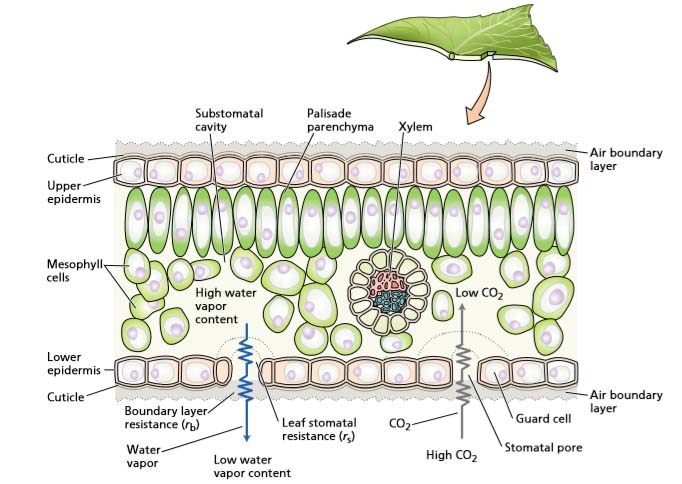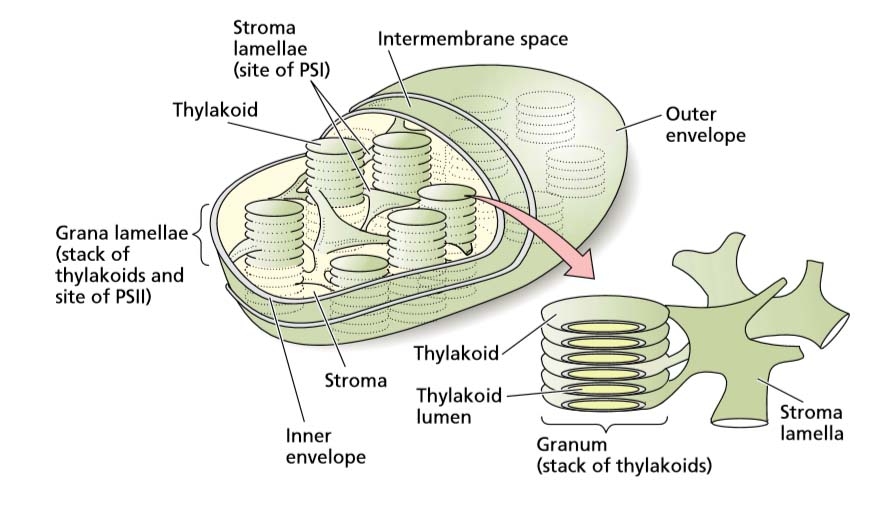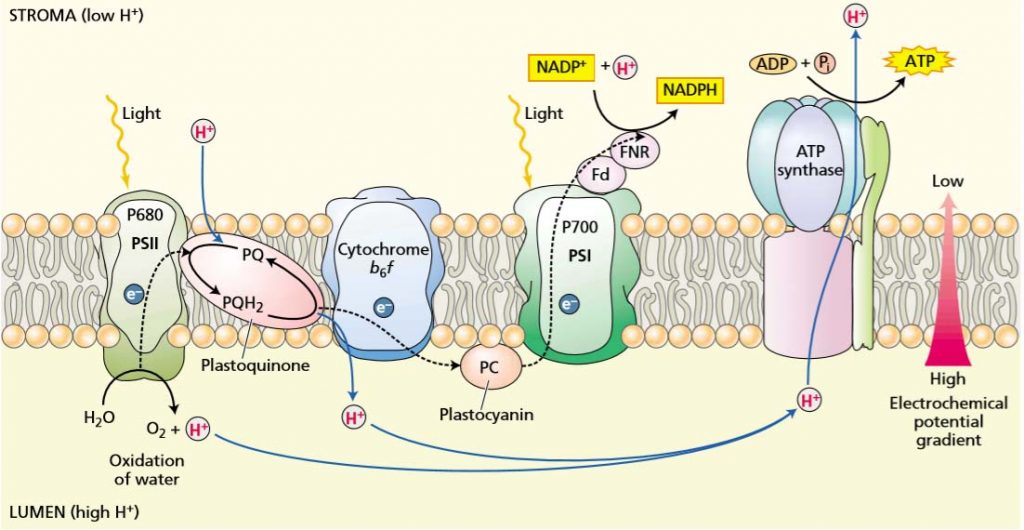The leaves are modified for maximum absorption of light.
Anatomy of leaf
Epidermis:
The leaf is sheathed with upper and lower epidermis. The exposed surfaces of the epidermal cells are coated with a cuticle.
Mesophyll
The photosynthetic tissues are located between the two epidermal layers and are consequently identified as mesophyll (meso,middle; phyll,leaf) tissues.
Palisade Mesophyll:
The upper photosynthetic tissue generally consists of one to three layers of palisade mesophyll cells. Palisade cells are elongated, cylindrical cells with the long axis perpendicular to the surface of the leaf.
Spongy Mesophyll:
Below is the spongy mesophyll, so named because of the prominent air spaces between the cells. The shape of spongy mesophyll cells is somewhat irregular but tends toward isodiametric.
The plan of a monocotyledonous leaf is similar except that it lacks the distinction between palisade and spongy mesophyll.
Palisade cells generally have larger numbers of chloroplasts than spongy mesophyll cells.

Chloroplast; site of photosynthesis

In photosynthetic eukaryotes, photosynthesis takes place in the subcellular organelle known as the chloroplast.
The most striking aspect of the structure of the chloroplast is the extensive system of internal membranes known as thylakoids.
The carbon reduction reactions, which are catalyzed by water-soluble enzymes, take place in the stroma (plural stromata), the region of the chloroplast outside the thylakoids.
Most of the thylakoids appear to be very closely associated with each other. These stacked membranes are known as grana lamellae (singular lamella; each stack is called a granum), and the exposed membranes in which stacking is absent are known as stroma lamellae.
Two separate membranes, each composed of a lipid bilayer and together known as the envelope,surround most types of chloroplasts.
Thylakoids Contain Integral Membrane Proteins
A wide variety of proteins essential to photosynthesis are embedded in the thylakoid membranes. In many cases, portions of these proteins extend into the aqueous regions on both sides of the thylakoids (integral membrane proteins).
Examples of integral proteins:
The reaction centers, the antenna pigment–protein complexes, and most of the electron transport enzymes are all integral membrane proteins.
Photosystems I and II
PHOTOSYSTEMS
There are two separate groups of pigments exist in thylakoid membrane of chloroplasts: one that absorbs long red wavelengths and called photosystem-I (PS-l), and the other absorbs wavelengths shorter than 680 nm and known as photosystem-II (PS-II). The two photosystems are linked together by an electron transport chain.
Composition of Photosystems
Photosystems-I (P700)
The photosystems-I contains chlorophyll a, small amounts of chlorophyll b and beta-carotenes (about 50 molecules) attached to proteins by non-covalent bonds. One of the chlorophylls a molecule absorb light near 700 nm as well as at shorter wavelengths. Two iron-containing proteins called Fe-S proteins are also present in PS-I.
Photosystems-II (P680)
Photosystems II consists of about 200 molecules of chlorophyll a and b, and about 50 carotenoids. a chlorophyll a molecule is able to absorb wavelength less than 680 nm. A quinine called Q closely associated with phaeophytin, and protein which accepts excited electrons of P680. It also contains one or more Mn-containing proteins.
Location of Photosystems
The two photosystems are spatially separated PS-II is located predominantly in the membranes of grana thylakoids (stacked regions of grana lamellae), whereas the PS-I is found almost exclusively in the membranes of stroma thylakoids and at the edges of the grana thylakoids.
Antenna Systems or Light Harvesting Complexes
These pigments act as light absorbing antenna systems and deliver harvested (absorbed) energy to their respective reaction centres. Each Light harvesting complex (LHC) contains molecules of chlorophylls a, b and xanthophylls but little beta-carotenes. There are two LHCs, LHC-I and LHC-II associated with PS-I and PS-II respectively.
